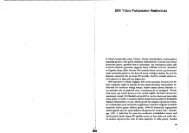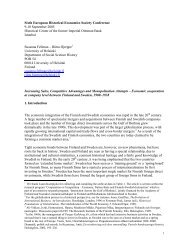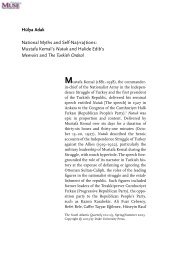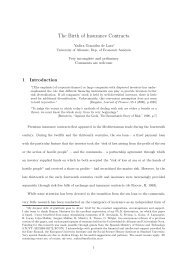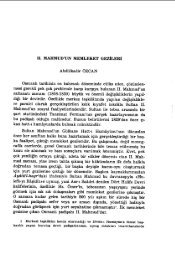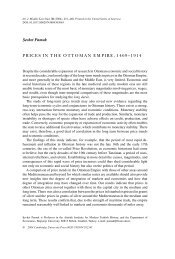West Riding – Western Rhineprovince, 1790-1840: Diverse Paths to ...
West Riding – Western Rhineprovince, 1790-1840: Diverse Paths to ...
West Riding – Western Rhineprovince, 1790-1840: Diverse Paths to ...
Create successful ePaper yourself
Turn your PDF publications into a flip-book with our unique Google optimized e-Paper software.
<strong>West</strong> <strong>Riding</strong> <strong>–</strong> <strong>West</strong> of the Rhineland, 1780-<strong>1840</strong> 38<br />
Alfred Reckendrees, University of Cologne reckendrees@wiso.uni-koeln.de<br />
list is biased <strong>to</strong>wards small firms (the manufacturing establishments counted in the 1851<br />
census returns probably included employees of the domestic industry but the <strong>to</strong>tal number<br />
of establishments (and workers) should than be higher than the number of the mills (establishments<br />
that employ water or steam engines). However, it seems <strong>to</strong> be evident that the<br />
small mill dominated in the <strong>West</strong> <strong>Riding</strong> cloth industry in the first half of the 19 th century.<br />
In general, this applies <strong>to</strong> the Rhenish district, <strong>to</strong>o.<br />
The account of Jenkins (table 8, above), however biased <strong>to</strong>wards larger establishments,<br />
suggests that about 50% of the workforce of the <strong>West</strong> <strong>Riding</strong> was employed in mills with<br />
more than 50 employees. Apart from Jenikin’s findings there are no other published data<br />
that provide further information concerning the size range of the fac<strong>to</strong>ries. The published<br />
accounts of Jenkins & Ponting and Julia de Lacy Mann (table 10) only provide <strong>to</strong>tal figures<br />
of mills and employees of the woollen cloth manufacture.<br />
Table 10: Mills and employees of the English woollen cloth industry, 1835-1867<br />
England<br />
&Wales Yorkshire<br />
mills employees, 1000 employes per mill<br />
<strong>West</strong> of<br />
England**<br />
England<br />
&Wales Yorkshire<br />
<strong>West</strong> of<br />
England**<br />
England<br />
&Wales Yorkshire<br />
<strong>West</strong> of<br />
England**<br />
1835 995 406 205 47,8 23,6 12,6 48,0 58,1 61,5<br />
1850 1306 880 147 64,4 40,6 11,1 49,3 46,1 75,5<br />
1856 1282 806 115 69,1 43,0 10,0 53,9 53,3 87,0<br />
1861 1456 924 107 76,3 50,5 10,1 52,4 54,7 94,4<br />
1867 1420 818 116 105,1 62,3 12,1 74,0 76,2 104,3<br />
Figures for England/Wales (1835, 1850) exclude a figure (~100?) for spinning and weaving mills in Lancashire<br />
** Wiltshire, Somerset and Gloucester. Totals for 1835 are not complete<br />
The figures for Yorkshire are the figures for the <strong>West</strong> <strong>Riding</strong>.<br />
Sources: Jenkins/Ponting, British Wool (1987), 80, Table 14: United Kingdom woollen industry; Mann, Cloth (1971), 220p.<br />
However, regarding the figures of the average employment per mill it seems as if the cloth<br />
fac<strong>to</strong>ries in the west of the Rhineland (defined as establishments that use power machines<br />
and work machines) were at least as large as the fac<strong>to</strong>ries of the <strong>West</strong> <strong>Riding</strong>. This may be<br />
concluded by the information on Aix-la-Chapelle concerning the year 1849 (table 11). For<br />
this year there is the most comprehensive collection of data for one year; however, this are<br />
the figures about which Haßlacher, the district administra<strong>to</strong>r and chief of police, complained<br />
so much (see above). Probably the employment and the number of looms are overestimated,<br />
but I will take this figures for granted for my preliminary considerations.<br />
According <strong>to</strong> the definition of the fac<strong>to</strong>ry there were 19 cloth fac<strong>to</strong>ries which employed<br />
more than 8.200 working people (13% children); these mills had 27.440 spindels for woollen<br />
yarn (either jennies or mules?) and about 1.150 of the working people were occupied<br />
with spinning and wool preparation and the mills. 142 Spinning and finishing machinery was<br />
operated by only one steam engine at 15 h.p. 143<br />
142<br />
Gewerbe-Tabelle der Fabrikations-Anstalten und Fabrik-Unternehmungen aller Art des Regierungs-<br />
Bezirks Aachen für das Jahr 1849, in: DSTA BR 2116-48, F.319pp.<br />
143<br />
Nachweisung derjenigen Fabrikationszweige, welche zusammen eine Anstalt bilden, in der Gewerbe-<br />
Tabelle der Fabrikations-Anstalten pp. des Regierungs-Bezirks für das Jahr 1849/50 aber in verschiedenen<br />
Kolumnen vertheilt sind. DSTA BR 2116-49, F. 80pp.



